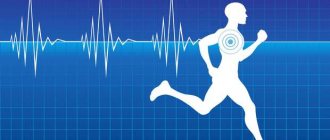The heart is one of the most important human organs. Thanks to its stable and proper functioning, other organs are saturated with oxygen and nutrients. Supporting the vital functions of the body is possible only if the compressor capacity of the heart muscle is normal. This especially applies to people involved in sports, both professional and amateur. Even if you go to the gym and your workouts are far from exhausting, you should know your level of maximum load or the so-called effective heart load index.
How does the heart work normally?
How does exercise affect the heart?
Is it possible for heart damage due to exercise?
How to avoid heart problems?
What is the effective heart load index (VIDEO)
What are the contraindications to physical activity?
How does the heart work normally?
The organ is a large muscle that constantly contracts. Even a 5-6 minute stop in its work leads to irreversible changes in the life of the entire organism. Cardiologists and sports medicine specialists recommend paying attention to the heart rate (HR) or pulse during exercise. If the heart rate exceeds the norm, then the load is considered excessive; if it is less than the norm, then it is insufficient. There are also physiological characteristics of the body that can affect changes in heart rate.
Using the Haskell-Fox formula, you can calculate the normal heart rate during physical activity: 220 minus the number of full years. It is important to remember that the correct functioning of the heart muscle and the normal heart rate will vary from different types of loads and from the fitness of the body. In this case, only a specialist - a cardiologist - can help you.
There are 2 types of load: volume and resistance.
With the first type of load, the heart stretches due to increased blood flow. Under the influence of regular cardio training, the stretching is maintained and increases in volume. Stroke and minute blood volumes become larger, more blood is released per contraction and heart rate decreases. Therefore, athletes' heart rate is normally lower than that of people without an active lifestyle.
In the second type, the load involves pumping blood through effort. In people without frequent physical activity at a high heart rate (180 and above), the heart muscle has to work through resistance; its chambers do not have time to push out blood and fill up, contracting too often.
Also, in overweight people, the heart has to pump blood through excess fat. At the same time, it increases due to hypertrophy (thickening of the fibers of the heart muscle), the volumes of the cavities do not change.
Digital heart rate readings while running
It would be a good idea for any runner to know their maximum heart rate. It is believed that this figure varies from 220 to 226 beats per minute. In this case, age should be subtracted from the characteristics. Such calculations were accepted several years ago. Now more and more doctors argue that this indicator cannot be taken as a basis. This is explained by the fact that for beginners such numbers may be too large.
In addition, each body works in its own unique mode.
It is believed that when performing a full warm-up, the heart rate should reach 50-60% of the maximum. This will allow you to safely and gradually prepare the body for the upcoming load. For a thirty-year-old man, parameters from 95 to 114 are acceptable. A woman of the same age should have a pulse from 98 to 118 beats per minute.
The same upper limit is relevant for those who are just starting to run.
After a few workouts, if your heart rate remains stable throughout the half-hour session, you can increase the intensity according to your goals.
For workouts that are aimed at combating excess weight, the heart rate should vary from 60 to 70% of the maximum figure. The norm for a thirty-year-old man is between 114 and 133 heart beats. A woman of the same age should not go beyond 118 - 137 beats per minute.
When running, which trains the endurance of the heart muscle, the contraction frequency should be 70-80% of the maximum load. At the same time, the lower limit for a thirty-year-old man should not be 133, and the upper limit should not be 152. For women of the same age, these figures are 137 – 157 beats.
Running to train the respiratory system involves a heart rate of 80-90% of the maximum level. Indicators for a thirty-year-old man should be 152 - 171, and for a woman - 157 - 176 contractions.
The so-called “red zone” includes a heart rate from 90 to 95% of the maximum. It is this kind of load that will allow you not to harm the body, strengthen and improve its health.
Sometimes you can hear from experienced marathon runners a recommendation to run at a low heart rate. This opportunity is only possible for very trained people, for whom a contraction frequency of 40 to 50 beats per minute is not considered critical. Running at a low heart rate is also useful for beginner runners. And moderate intensity loads will allow you to achieve this faster.
Some experts offer another calculation, which is as follows. The maximum heart rate should be 208 subtracting 70% of the age. And even this technique, which is followed by a large number of doctors, has its opponents. In their opinion, such calculations should be carried out only on an individual basis. Therefore, the correct heart rate can be safely taken as the one at which the runner breathes calmly through his nose and feels great.
How does exercise affect the heart?
With any type of training intensity, the muscles begin to work, during which their need for oxygen increases, the heart muscle begins to contract more often in order to fill this need. When the heart works intensively, blood pressure (BP) increases, and the body has to launch the hypotensive system, which is responsible for reducing it.
To obtain energy to carry oxygen, the body first burns carbohydrates. After a 15-20 minute workout, it begins to burn fat. The hormonal system of the adrenal glands and thyroid gland also begins to work, and the composition of the blood improves. Due to the work of the muscles that compress the vessels, pushing out blood, then relax filling the vessels with blood, the load on the heart is reduced. Therefore, even a little physical activity is beneficial for people even with severe heart disease.
Interval and tempo training
Vasily Permitin: Interval and tempo training is the main type of developmental training that athletes use to improve results. All plans consist of a combination of low-intensity and high-intensity training.
Tempo training is running in a threshold zone, usually at the beginning of the 3rd, that very mixed, or between the 3rd and 4th zones at the threshold of anaerobic metabolism. This is a fairly long moderate-to-hard run. The intensity is best controlled by pulse. Very often amateurs make the mistake of running tempo training in zone 5, but this has nothing to do with tempo running - this is already a competitive mode.
Interval training is aimed at developing slightly different qualities. As I already said, the threshold for anaerobic metabolism can be developed and shifted with different training protocols. Accordingly, interval work can be either speed work to develop speed qualities and the ability to run quickly, or work to develop the ability to run for a long time at high speed. Due to this, the anaerobic threshold shifts. Depending on the tasks, the intensity and duration of fast segments, as well as the duration of rest intervals, are selected.
Is it possible for heart damage due to exercise?
Any physical activity, and especially stress on the heart, should be done wisely. If after training you experience pain in the chest area or a change in rhythm, you should consult your doctor. A specialist will help you figure out the right way to strengthen your heart muscle. Any activity is stressful for an unprepared body, and if you do not know your level of permissible effective load on the heart, you can get serious consequences:
- pain in the heart area;
- arrhythmia;
- cardiac hypertrophy;
- bradycardia;
- hypotension;
- exacerbation of existing diseases;
- myocardial infarction.
What to do if your sneakers rub
Sardana Trofimova: Your feet may chafe because the sneakers are new and not yet worn in. You also need to be careful during long workouts: when you run for a long time, you sweat, and salt comes out. It can lead to chafing.
That's why before every long workout and before a marathon, I smear Vaseline on all my fingers, between my fingers and in places where it might rub. Sometimes even my top rubs. Therefore, I smear any places where chafing may occur with Vaseline - it’s enough for me for the entire distance, I can easily run a marathon.
I would also like to advise amateurs not to wear new sneakers and new socks to the competitions. You definitely need to wear them for at least a week, and run in them at least a couple of times, so that the sneakers become softer. And you also need to run in new socks at least three times and wash them.
How to avoid heart problems?
Modern man is accustomed to solving problems as they arise. But it is important to remember that preventing diseases is easier than treating them. A cardiologist is responsible for the normal functioning of the heart muscle and helps to identify malfunctions in its functioning in a timely manner. Preventive consultations are necessary even for healthy people. The doctor can tell you what tests need to be done in your case:
- blood test from the group of cardiac risk indicators (AST, ALT, C-reactive protein, cholesterol, triglycerides)
- ECG
- EchoCG
- blood pressure monitoring
- Holter ECG monitoring (daily or during training)
The most important thing for maintaining heart health is timely medical care or timely preventive measures. In this case, private medicine has the opportunity to provide clients with a flexible schedule at a time convenient for them, without queues and stress. The presence of modern equipment and highly qualified doctors, which is also important for maintaining health and for the correct treatment of already known diseases.
Ways to measure heart rate while running
And although your general condition during a run is the best indicator of good health, in some cases, measuring your heart rate during exercise is necessary. You can do this in the following ways:
- Counting beats on the carotid artery or wrist. It is in these places that the pulse is best felt. The number of hits in 15 seconds is determined and the indicator is multiplied by 4. It is worth considering that this method is not absolutely accurate. In addition, it is not entirely convenient.
- Using a heart rate monitor (cardiometer). Among the many varieties of these devices, the models with a chest mount are the most convenient. A sensor located on the belt transmits readings to a monitor that looks like a wristwatch. Devices that measure your pulse with the touch of a finger may not give accurate results in certain weather conditions. The undoubted advantages of these gadgets include a sound signal that will sound if the specified heart rate threshold is exceeded.
Paying attention to your health and well-being will allow you to fully enjoy life.
Jogging at the usual level
For professionals and simply physically developed people who regularly engage in such exercises, this is normal.
When the rate exceeds the normal level, the runner temporarily returns to a walk, waits for the heart rate to decrease, then accelerates again. Usually he moves at this rhythm for half an hour.
It is important to observe your own breathing. Each inhalation and exhalation is usually deep and unhurried, the duration of each repeats the previous one. This makes it easier to recover and not stop.
If you try to run, despite your heart jumping out of your chest, then instead of a quality workout you will only get harm.
Who should I turn to for help with organizing the training process?
Without deep knowledge of the organization and functioning of the body, it is difficult to organize a training regimen in the right way on your own. A fitness instructor handles this mission. If you decide not to go to the gym, but to run on your own, a sports doctor will come to the rescue.
A sports doctor is a specialist who understands a healthy lifestyle and proper methods of losing weight. He will determine the state of the body, allow you to train and decide which sports you have a genetic and phenotypic predisposition to. The doctor will adjust the dynamics of the loads according to the functional capabilities and select the optimal exercises for developing endurance (a set of pedagogical, medical-biological, psychological and pharmacological techniques). A sports doctor also treats occupational injuries and illnesses.
Another highly specialized specialist in sports medicine is a rehabilitation specialist or exercise therapy doctor. Helps restore the functions of the musculoskeletal system by selecting the optimal complex of physical therapy.
When fat is burned
Any running will provoke energy expenditure. With a normal or reduced heart rate, they are considered most effective. But with such loads, the duration of the race is of great importance. Only after half an hour the body stops using carbohydrates for breakdown and begins to use its own fat deposits. Therefore, an hour-long run becomes as useful as possible.
Beginners and untrained sports enthusiasts should start with a short jog. When the body gets used to it, you can move on to races with short transitions to intense running.
When this rhythm becomes familiar, add small sharp transitions to acceleration in easy mode. Another effective way to get fit is to move on rough terrain. Climbing up and down hills has a great effect on the cardiovascular system. If you follow these tips, you will lose much more fat from your waist.
Pulse zones
To understand what a running heart rate zone is, you need to decipher the concept itself. So, the pulse is the rhythmic vibrations of the walls of the vessels in which the blood flows. Between the normal heartbeat at rest and the upper limit of the pulse, at which the body is at the limit of its capabilities, there are 5 pulse zones. They determine the intensity of the workout and the athlete's level of preparation.
- Low intensity zone - heart rate 115-120 beats/min. Ideal level for beginners;
- Low or fitness zone - heart rate 120-135 beats/min. This workout improves endurance well, and also provides the optimal heart rate when running to burn fat;
- Aerobic zone - 135-155 bpm. Such exercises well train the aerobic capabilities of the body.
- Anaerobic zone - 155-175 beats.min. Jogging in such a zone helps to increase speed capabilities and break previously achieved records;
- The red zone - 175-190 - is the zone of maximum load and performance. Only professional athletes allow themselves to do such training. For amateurs, they are categorically contraindicated, since if not properly organized they can undermine their health.
How to run according to your heart rate and how to control it
To run correctly based on your heart rate, you need to draw up a training plan; for this, your heart rate needs to be monitored before the load, after maximum intensity and at the end of the session. At least 2-3 times a week, take your resting pulse. To safely achieve good results, it is best to contact a trainer (for a healthy person), a rehabilitation doctor or exercise therapy instructor (for diseases).
The approximate load ratio looks like this:
- running with a slow heart rate of 115-125 beats/min – 2 workouts per week;
- cross with high heart rate 150-155 beats/min – 1 workout per week;
- interval running – 1 workout per week.
Methods for calculating MHR
Now you understand why athletes strive to calculate their maximum heart rate. Let's learn how to do this in three different ways.
Formulas (Table)
There are a huge number of formulas for calculations, which differ in the coefficient and the data used. The more of your individual parameters are taken into account (gender, age), the more accurate the indicator will be. Let's calculate the MHR using different formulas for a 40-year-old woman.
| Formula | Calculation | Example |
| Haskell-Fox | 220 - age | 220 – 40 = 180 beats/min |
| Londeri-Meshberger | 206.3 – (0.711 x age) | 206.3 – (0.711 x 40) = 178 beats/min |
| Tanaka | 208 – (0.7 x age) | 208 – (0.7 x 40) = 180 beats/min |
| Miller | 217 – (0.85 x age) | 217 – (0.85 x 40) = 183 beats/min |
| Roberges-Landwehr | 205.8 – (0.685 x age) | 205.8 – (0.685 x 40) = 178 beats/min |
| Jackson | 206.9 – (0.67 x age) | 206.9 – (0.67 x 40) = 180 beats/min |
| Vaita | for men: 202 – (0.55 x age) | 202 – (0.55 x 40) = 180 beats/min |
| for women: 216 – (1.09 x age) | 216 – (1.09 x 40) = 172 beats/min | |
| Ball State University | for men: 214 – (0.8 x age) | 214 – (0.8 x 40) = 182 beats/min |
| for women: 209 – (0.9 x age) | 209 – (0.9 x 40) = 173 beats/min |
As we can see, the results are different. Formulas that take into account age and gender show lower maximum heart rate values for women, which is true. Therefore, try to focus on them.
Laboratory methods
Laboratory tests to determine MHR are more accurate; they are carried out in medical institutions under the supervision of doctors. There are 2 ways to calculate maximum heart rate: treadmill test and bicycle ergometry.
Treadmill test
The doctor attaches sensors to the patient’s chest to determine the work of the heart, and also uses a device to analyze the gas composition of exhaled air.
Then the person gets on the treadmill and begins to gradually perform the load. The doctor increases the speed of the treadmill and the angle of inclination of the belt (intensity).
At the same time, all indicators of the body are constantly measured, including heart rate. When a person can no longer cope, the load is gradually reduced, and the heart rate is fixed at its peak. This is its maximum level.
Bicycle ergometry
It is carried out in exactly the same way as the treadmill test, but on an exercise bike. Increases pedal resistance. The assessment of indicators is the same.
Field tests
An excellent way to measure MHR is by actually running and recording your heart rate. There are three options for such tests.
Option 1
Run 1.6 km as fast as possible, accelerating in the last meters before the finish. Measure your heart rate immediately.
If you are practicing the test for the first time, be sure to take a partner with you to help you monitor your performance.
Option 2
Run 2 x 800m segments with 5m recovery at a slow pace between segments. At the end of each 800 m segment, accelerate as much as possible. In the last meters of the distance, measure your MHR level.
Option 3
Do a 2 minute hill run at a moderate pace (which you could hold for 20 minutes).
Then repeat the races faster, and the third time - at the maximum pace until halfway and measure the MHR. Go down each time at a calm jog.











